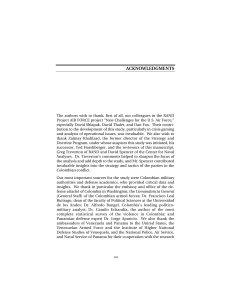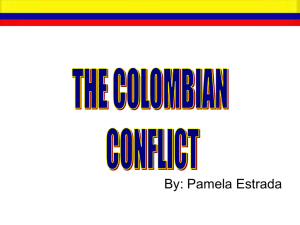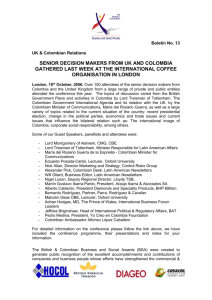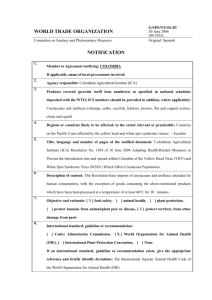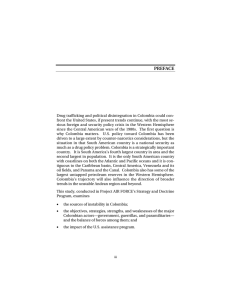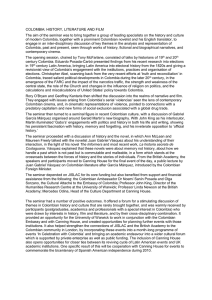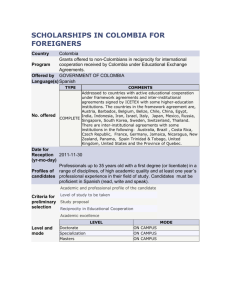IMPLICATIONS FOR U.S. INTERESTS
advertisement
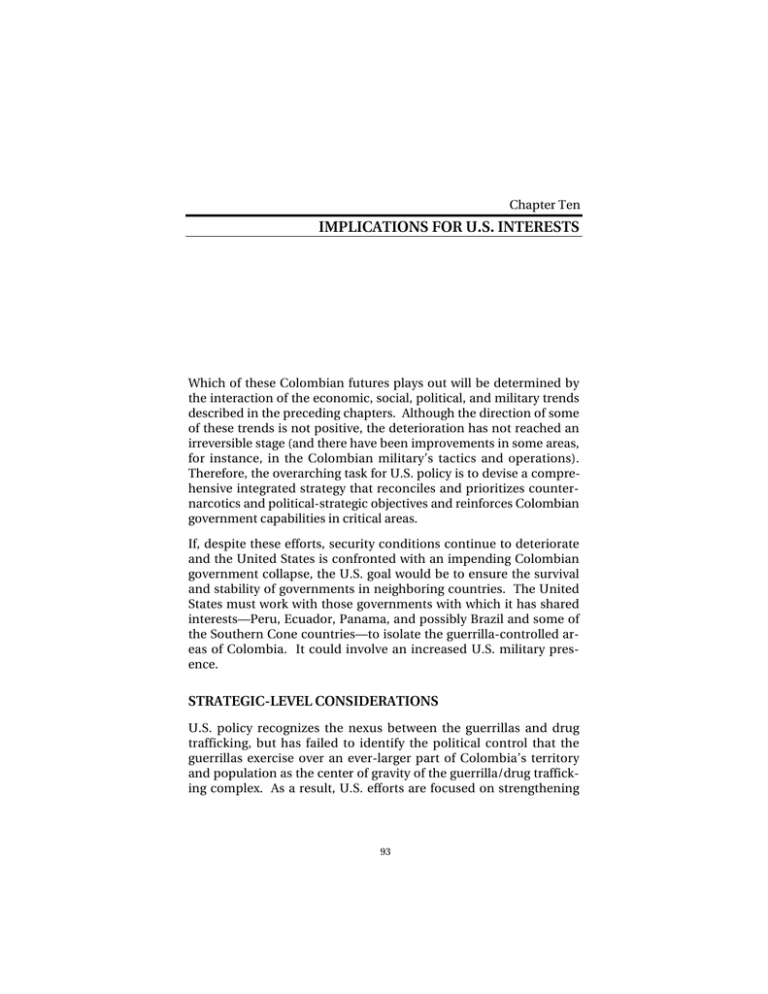
Chapter Ten IMPLICATIONS FOR U.S. INTERESTS Which of these Colombian futures plays out will be determined by the interaction of the economic, social, political, and military trends described in the preceding chapters. Although the direction of some of these trends is not positive, the deterioration has not reached an irreversible stage (and there have been improvements in some areas, for instance, in the Colombian military’s tactics and operations). Therefore, the overarching task for U.S. policy is to devise a comprehensive integrated strategy that reconciles and prioritizes counternarcotics and political-strategic objectives and reinforces Colombian government capabilities in critical areas. If, despite these efforts, security conditions continue to deteriorate and the United States is confronted with an impending Colombian government collapse, the U.S. goal would be to ensure the survival and stability of governments in neighboring countries. The United States must work with those governments with which it has shared interests—Peru, Ecuador, Panama, and possibly Brazil and some of the Southern Cone countries—to isolate the guerrilla-controlled areas of Colombia. It could involve an increased U.S. military presence. STRATEGIC-LEVEL CONSIDERATIONS U.S. policy recognizes the nexus between the guerrillas and drug trafficking, but has failed to identify the political control that the guerrillas exercise over an ever-larger part of Colombia’s territory and population as the center of gravity of the guerrilla/drug trafficking complex. As a result, U.S. efforts are focused on strengthening 93 94 Colombian Labyrinth Colombian antinarcotics capabilities while insisting that U.S. military assistance is not directed against the guerrillas. This is unrealistic, given the Colombian government’s inability to eradicate the drug trade where it does not have physical control and the magnitude of the political and military threat it faces from the guerrillas and paramilitaries. This is not to say that the struggle against drug traffickers and what Colombians call “generators of violence” could not go on simultaneously. It should, but within the framework of a comprehensive national strategy that commits the Colombian government to undertake the effort required to reverse the downside trends and reestablish the authority of the state in areas controlled or contested by nonstate actors, whether guerrillas, paramilitaries, or drug traffickers. Plan Colombia incorporates elements of a national strategy, but there is no clear link to a military strategy.1 The United States should reexamine the effectiveness of some of the counter-narcotics strategies that it is currently pursuing and their effects on political stability; in particular, it should review whether aerial fumigation of coca corps is the most effective means of reducing coca production at an acceptable social and political cost. Alternative strategies, such as targeting bottlenecks in the drug refining and transportation network in Colombia, should be explored. If fumigation is considered essential, it is important to know whether fumigation efforts are linked to workable crop substitution and infrastructure development. Absent viable economic alternatives, fumigation may simply displace growers to other regions and increase support for the guerrillas. The United States should also reexamine the utility of distinguishing between counter-narcotics and counter-insurgency assistance and consider providing assistance to improve Colombia’s conventional military capabilities. Additionally, the United States should seek to balance and integrate its own unilateral initiatives with multilateral policies that are taken ______________ 1The link is indirect: the Colombian government’s assumption is that attacking the guerrillas’ sources of income in the drug trade will reduce their resources and ability to prosecute the war. Implications for U.S. Interests 95 in conjunction with relevant international bodies, nongovernmental organizations, and other hemispheric states.2 Apart from these practical measures, the United States should acknowledge the critical role that American consumer demand plays in encouraging cocaine and heroin exports from Colombia and accordingly accept at least some degree of co-responsibility for the problem. OPERATIONAL-LEVEL IMPLICATIONS Beyond the development of a comprehensive national strategy, the Colombian government needs to develop adequate instrumentalities to implement its strategy—especially a capable military force. It would require a thoroughgoing military reform, including implementation of the Colombian High Command’s goal of replacing conscripts—who currently constitute 70 percent of military personnel— with an all-volunteer force, and remedying weaknesses in mobility, intelligence, and communications. 3 The recruitment, training, and equipping of a modern and efficient military force will take substantial resources. The Colombian defense budget for the year 2000 is 3.5 percent of GDP, a level that might be appropriate for peacetime, but falls well short of what the present emergency requires. The United States is the only realistic source of military assistance to the Colombian government on the scale needed to redress the currently unfavorable balance of power. Further assistance will be needed, beyond the $862.3 million (out of a $1.3 billion package) approved for Colombia by the U.S. Congress in 2000. The U.S. program of military assistance to El Salvador during the Reagan administration could be a relevant model. Although U.S. military assistance to El Salvador was a matter of considerable political controversy, there is no question that it succeeded in transforming the unprepossessing Salvadoran military into a force capable of turning back a formidable guerrilla threat. ______________ 2See, for instance, Shifter, “The United States and Colombia: Partners in Ambiguity,” p. 55. 3Military Professionals Resources Inc. (MPRI), a private organization staffed by retired U.S. officers and NCOs, received a contract from the U.S. government to assist in the modernization of the Colombian armed forces. It is too early to assess the results of the MPRI work in Colombia. 96 Colombian Labyrinth Clearly, not all of the lessons of the Salvadoran war of 20 years ago are applicable to Colombia today, but some experiences apply, particularly at the operational and tactical level. The key lesson from El Salvador is the need to move forces out of static defense, to the extent possible, and remake them into mobile units to retake the initiative from the guerrillas and progressively clear them out of economically strategic areas. It would require the development of rapid reaction capabilities, including transport and attack helicopters, long-range reconnaissance assets, and intelligence collection and dissemination, particularly signals intelligence (SIGINT) for order-ofbattle information. The United States could help the Colombian military in developing new concepts of operations to detect, identify, and attack light infantry (guerrilla) targets. Air-land synergies (which the Colombian military has employed in encounters since 1998) can be an effective counter to the guerrilla tactic of massing for attack on isolated government positions or units. On-call air power can be a force multiplier, especially where the government forces on the ground can direct the fire of supporting air assets. If the guerrillas disperse to avoid the air attacks, they are vulnerable to attack by government ground forces. Effective employment of air power against light infantry would require precise information on the type, location, and activity of the target. Newly developed sensors, weapons, and analytic tools could be well suited to the Colombian environment. Light infantry forces produce signatures that can be detected by a variety of sensors. Advances in sensor technology and data processing over the last decade make it possible to detect low-contrast targets and handle high-datarate flows. Small unmanned aerial vehicles (UAVs) have great potential for low-altitude surveillance missions; they could be equipped with foliage-penetrating radar or other types of active or passive sensors. Another possibility is unattended ground sensors. A streamlined command and control architecture would be needed to strike targets while they are exposed.4 ______________ 4 For a detailed discussion, see Alan Vick et al., Enhancing Air Power’s Contribution Against Light Infantry Targets, RAND, MR-697-AF, 1996. Implications for U.S. Interests 97 Maintaining road control is critical to prevent the guerrillas from fragmenting the country, but it is exceptionally difficult because of Colombia’s topography. The FARC has built improvised armored vehicles using bulldozers, tractors, and farm equipment. Armored vehicles for the Colombian army could be built locally, but their effective employment to keep the roads open would require air support. More effective use of riverine and amphibious forces would be an advantageous enhancement of Colombian military capabilities. As noted above, Colombia has 18,000 kilometers of navigable rivers, the avenues of transportation in southern and southeastern Colombia. What is required is an amphibious force capable of landing and maneuvering, with naval units providing suppressing and supporting fire.5 Satellite communications is a critical need. Currently, the Colombian army relies for military communications on 82 relay stations throughout the country. These relay stations are resource-intensive and vulnerable to guerrilla attack. Resources could be freed, vulnerabilities reduced, and communications reliability increased by helping the Colombians shift to satellite communications for their mobile military operations. REGIONAL COOPERATION At the same time, the United States needs to work with concerned South American countries to contain the risk of regional destabilization. The United States should begin to explore ways of helping countries such as Panama and Ecuador regain control of their borders with Colombia.6 Panama, as noted earlier, has become a critical node in the Colombian narcotraffickers’ and guerrillas’ support structure. Shutting down to the extent possible the narcotraffickers’ and guerrillas’ pipeline through Panama is vital to the success of any ______________ 5The authors are indebted to David Spencer for the ideas in this and the preceding paragraph. 6The U.S. supplemental assistance package for Colombia included modest amounts of counter-narcotics assistance for Peru ($32 million), Ecuador ($20 million), and a smaller amount for Panama. 98 Colombian Labyrinth U.S.-Colombian strategy. At the same time, the United States should help Panama fill the security vacuum in its southern province. To do that, the United States needs to help strengthen the (virtually nonexistent) capabilities of the Panamanian security services. Critical requirements are the following: • The National Police’s specialized unit needs to be strengthened with heavier equipment, communications, transport, and training so it can project a more robust presence in southern Panama. • The air service needs to develop nighttime operations, air monitoring, interceptor, and close air support capabilities. Specific requirements include radar with low-altitude capabilities; aircraft with interceptor and close air support capabilities; search and rescue equipment and training; antiterrorism equipment and training; and command, control, and intelligence improvements. • The naval service needs landing ships for transport of personnel and amphibious operations; radar with both air and sea surveillance capabilities; fuel storage facilities at bases close to the Colombian border to extend the naval service’s operational range; and specialized training for naval personnel. Border control might be amenable to multilateral solutions. Drug production in Colombia is dependent on precursor chemicals imported from the United States, Europe, and the Southern Cone countries. Similarly, the guerrillas are dependent on an international arms pipeline. Effective multilateral cooperation to interdict the flow of precursor chemicals and to deny the arms pipeline to the guerrillas would help to reduce the size of the problem. This effort will require strengthening the defense and interdiction capabilities of neighboring countries, especially Panama and Ecuador. The inter-American community should also begin to explore a regional response to the possible spread of Colombia’s war beyond its borders. The Speaker of the Panamanian legislature suggested the deployment of an international military force to southern Panama. Although such a deployment might be premature, the United States should actively pursue all avenues of regional defense cooperation and lay the groundwork for a multilateral response if the crisis in Implications for U.S. Interests 99 Colombia intensifies and threatens the stability of neighboring countries. CONCLUSIONS In the end, for the United States to address effectively the multiple crises in Colombia would require a conceptual shift. For the last decade Colombia has been viewed in the United States through the prism of the drug problem and counter-narcotics policy, but as this report has documented, the development of a drug economy in Colombia is inextricably linked to other factors of political and social disintegration. Strengthening the state and its institutions, including the armed and security forces—which bear the brunt of the struggle to reestablish the state’s authority—should be a critical focus of U.S. policy toward Colombia. It is also important to recognize that the United States has broader strategic interests in the region that are endangered by Colombia’s instability. A proactive U.S. policy would help the Colombians gradually to reduce the scope of the drug and insurgency problem; the policy should at the same time have a strong hedging element and lay the groundwork for a multilateral response if the crisis in Colombia intensifies.
